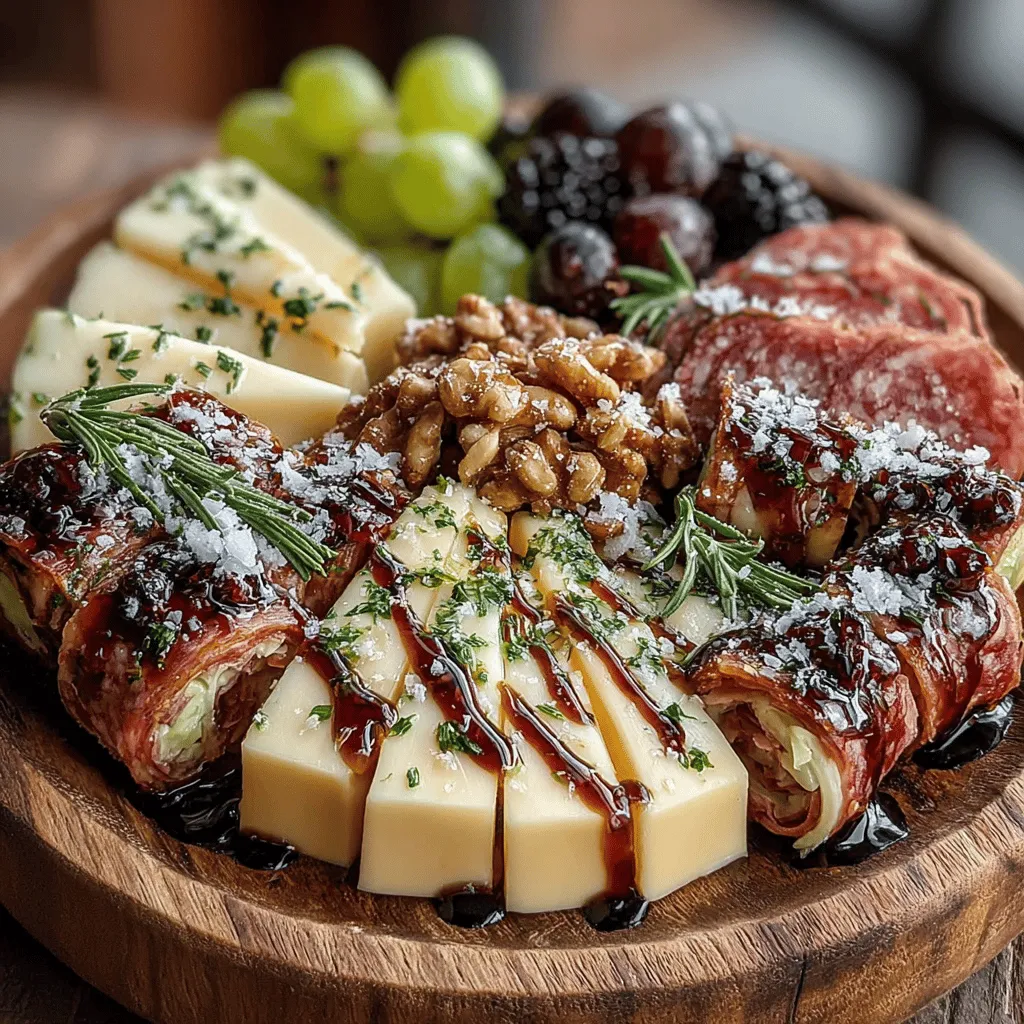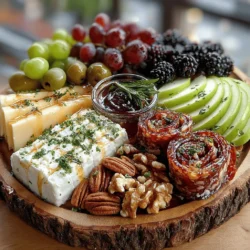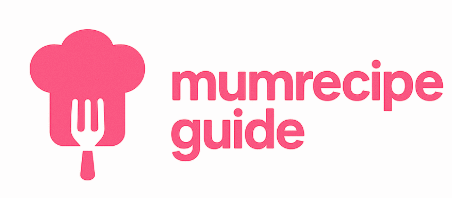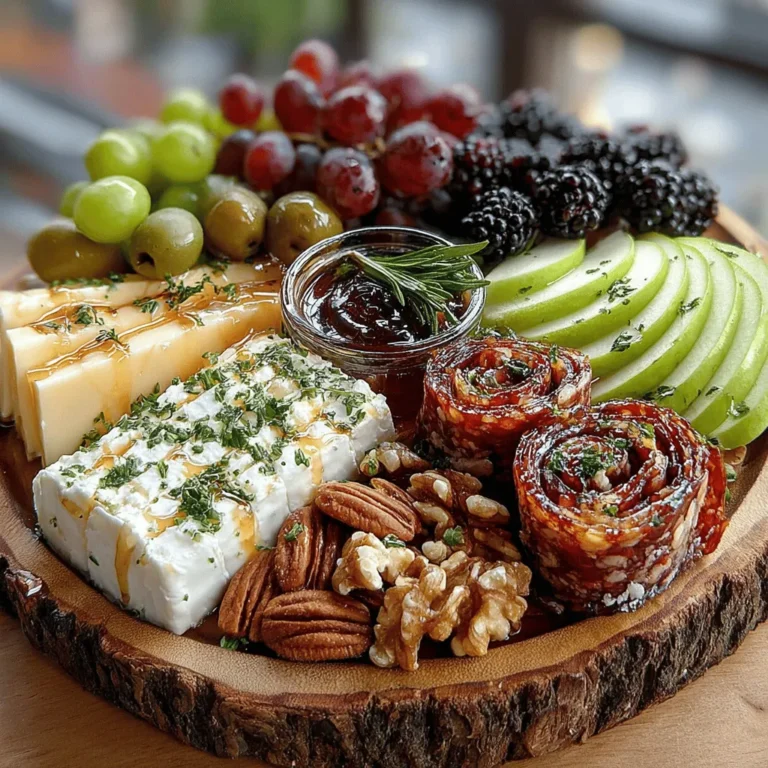Savory One-Pan Charcuterie Board: A Delightful Gathering Experience
Charcuterie boards have become a staple in social dining, captivating food lovers with their vibrant displays and diverse flavors. These enticing platters, typically laden with an assortment of cured meats, cheeses, fruits, and accompaniments, invite guests to indulge in a shared culinary experience. As gatherings grow more casual and interactive, charcuterie boards have surged in popularity, providing a communal way to enjoy food that encourages conversation and connection.
Among the various styles of charcuterie, the one-pan charcuterie board shines for its simplicity and elegance. This format not only streamlines the preparation process but also makes serving and cleanup a breeze. Picture a beautifully arranged spread that invites guests to explore a variety of tastes and textures, all while minimizing the need for elaborate serving ware. This recipe offers an effortless yet sophisticated option for gatherings, whether you’re hosting a lively party, enjoying a casual family night, or celebrating special occasions with friends.
In this article, we will guide you through crafting a savory one-pan charcuterie board that will impress your guests and elevate your dining experience. With thoughtful ingredient selection and an eye for presentation, you’ll create a harmonious balance of flavors that tantalizes the palate and delights the senses.
Understanding the Components of a Charcuterie Board
To build a successful charcuterie board, it’s essential to understand its fundamental components. While the combinations can be as diverse as your imagination allows, a well-rounded board typically includes a selection of savory and sweet elements, providing a delightful contrast that keeps guests returning for more.
Essential Elements of a Charcuterie Board:
1. Cured Meats: The heart of any charcuterie board lies in its meats. Options like salami, prosciutto, and chorizo offer a range of flavors from mild to robust, ensuring that every bite is a flavorful adventure.
2. Cheeses: A selection of cheeses is crucial for providing a creamy counterpoint to the meats. Varieties such as Brie, aged cheddar, and gouda bring unique textures and flavors, from soft and buttery to sharp and crumbly.
3. Fruits: Incorporating fresh and dried fruits introduces a natural sweetness that balances the savory components. Grapes, figs, apples, apricots, dates, and cranberries not only enhance the flavor profile but also add appealing colors to the board.
4. Nuts: Crunchy nuts like almonds, walnuts, or hazelnuts add a satisfying crunch and a dose of nutrition, making them a perfect addition to the mix.
5. Olives: Mixed olives, both green and black, contribute a briny depth of flavor that complements the other elements beautifully.
6. Crackers or Breadsticks: Providing a vehicle for the meats and cheeses, crunchy crackers or breadsticks enhance the overall experience. Selecting the right variety can elevate the board’s appeal.
7. Sweet Accents: Honey or balsamic glaze offers a touch of sweetness that helps to balance the savory components of the board, creating a harmonious flavor experience.
8. Fresh Herbs: Fresh herbs not only add a pop of color but also infuse the board with aromatic qualities, making it visually stunning and inviting.
9. Optional Extras: Consider including pickles or mustard for an extra layer of flavor, providing guests with more options to customize their bites.
A successful charcuterie board is a careful orchestration of flavors and textures. Balancing savory with sweet, crunchy with creamy, ensures that every palate is catered to and creates an enjoyable experience for all.
Selecting the Right Ingredients
Crafting a savory one-pan charcuterie board begins with selecting high-quality ingredients that complement one another. Here’s a closer look at the key components and how to choose the best options for your board:
Assorted Cheeses
– Brie: This soft cheese is creamy and rich, offering a luxurious texture that pairs well with both fruits and crackers. Its mild flavor makes it a favorite among cheese lovers.
– Aged Cheddar: With its sharp and nutty notes, aged cheddar adds depth to the board. It contrasts nicely with creamy cheeses and enhances the flavor of cured meats.
– Gouda: This semi-hard cheese is known for its slightly sweet, caramel-like flavor. Smoked gouda can introduce a delightful smokiness that pairs beautifully with many accompaniments.
Cured Meats
– Salami: Available in various styles, salami provides a robust and savory flavor. Look for varieties that are well-seasoned for the best taste.
– Prosciutto: This dry-cured ham brings a delicate, salty profile that complements the richness of cheeses and fruits. Its thin, silky slices are an elegant addition to any board.
– Chorizo: Offering a spicy kick, chorizo adds a bold flavor that contrasts with milder cheeses and sweet fruits, ensuring a dynamic tasting experience.
Mixed Olives
Incorporating both green and black olives into your board can create a delightful contrast in flavor. Green olives tend to be firmer and more tangy, while black olives provide a milder, buttery taste. This combination not only enhances the flavor depth but also adds visual variety to the spread.
Nuts
Choose a mix of nuts such as almonds, walnuts, or hazelnuts for their crunchy texture and nutritional benefits. Nuts contribute healthy fats and protein, making them a satisfying addition to your charcuterie board.
Fresh and Dried Fruits
Selecting a variety of fresh and dried fruits is essential for balancing the savory elements. Grapes provide a refreshing burst of sweetness, while figs and dates offer a chewy texture and intense flavor. Apples and apricots add a crispness that contrasts well with creamy cheeses.
Crunchy Crackers or Breadsticks
Opt for a selection of crunchy crackers that have different flavors and textures. Whole grain, herb-infused, or even spiced varieties can complement the meats and cheeses, enhancing the overall experience.
Honey or Balsamic Glaze
A drizzle of honey or balsamic glaze can elevate your board by adding a touch of sweetness. These elements help to balance the savory flavors, creating a well-rounded palate experience.
Fresh Herbs and Optional Extras
Incorporating fresh herbs like rosemary or thyme can enhance the aesthetic appeal of your board while imparting a delightful aroma. Additionally, consider adding pickles or mustard for an extra layer of flavor that can surprise and delight your guests.
Preparing Your Ingredients
Once you have selected the right ingredients, the next step is to prepare them for your savory one-pan charcuterie board. Here’s a step-by-step guide to ensure everything is perfectly set for your gathering.
1. Cheese Preparation: Begin by removing your cheeses from the refrigerator about 30 minutes before serving to allow them to reach room temperature, which enhances their flavors. Cut the cheeses into various shapes—cubes, slices, or wedges—for visual interest and easy serving.
2. Meat Arrangement: Arrange the cured meats in a visually appealing manner. Consider rolling the prosciutto slices and folding the salami into quarters for a dynamic presentation. The chorizo can be sliced into rounds and grouped together.
3. Fruit Placement: Rinse fresh fruits like grapes and apples. If using apples, slice them just before serving to prevent browning. You can also leave some whole for a rustic look. Dried fruits should be placed in small clusters or scattered across the board for an inviting touch.
4. Nut Distribution: Place the nuts in small piles or in a decorative bowl on the board. This not only adds texture but also provides a great snack option for guests.
5. Cracker Arrangement: Arrange the crackers or breadsticks in a way that makes them easily accessible. You can either fan them out or stack them for an organized appearance.
6. Add Sweet Accents: Drizzle honey or balsamic glaze over a section of the board or place it in a small dish for easy dipping. This not only adds sweetness but also contributes to the overall presentation.
7. Finishing Touches: Scatter fresh herbs around the board for a pop of color and aroma. If using pickles or mustard, place them in small bowls or directly on the board to invite guests to try them.
By thoughtfully preparing each component, you’ll create a visually stunning and delicious one-pan charcuterie board that is sure to impress your guests and provide a delightful social dining experience. As you continue through this recipe, remember that the joy of a charcuterie board lies not only in its flavors but also in the connections it fosters among those who gather around it. Enjoy the process of assembling your board, and let the flavors mingle and shine through in every bite.

Tips for Slicing Cheeses into Appealing Shapes
The way you slice your cheeses can greatly enhance the visual appeal of your charcuterie board. Here are a few tips to keep in mind:
1. Variety of Shapes: Use a mix of shapes to create interest. For example, cube hard cheeses like aged cheddar or gouda, while soft cheeses like brie can be sliced into wedges or served whole. This not only adds diversity but also encourages guests to explore different flavors.
2. Thickness Matters: Aim for uniform thickness when slicing. About ¼ to ½ inch slices work well for most cheeses. Thicker slices can be daunting and difficult to manage, while thinner slices might break apart too easily.
3. Use the Right Tools: A sharp cheese knife or wire cutter will make clean cuts, especially for softer cheeses. For harder varieties, a heavy-duty knife will ensure you can slice without crumbling.
4. Temperature Check: Serve cheeses at room temperature for optimal flavor. If your cheese has been refrigerated, take it out about 30 minutes before serving to allow it to soften.
Creative Ways to Present Cured Meats
The presentation of cured meats can be just as important as the selection of flavors. Here are some creative techniques:
1. Rolling: Thin slices of salami or prosciutto can be rolled into small cylinders. This not only makes them easy to pick up but also adds height and dimension to your board.
2. Folding: Another technique is to fold slices in half or even quarters. This creates a lovely layered effect and makes the meat appear more abundant.
3. Layering: Stack slices in a fan shape or create a small pile. This method gives a rustic charm and allows guests to easily grab portions without creating a mess.
4. Mixing Textures: Combine different types of cured meats with varying textures (e.g., smooth prosciutto with peppery salami) to provide a more intricate tasting experience.
Importance of Washing and Properly Cutting Fresh Fruits
Fruits not only add a refreshing contrast to the rich and savory items on your board, but they also enhance its aesthetic appeal. Here’s how to make the most of your fresh fruits:
1. Washing: Always wash your fruits thoroughly under running water. This not only removes pesticides and dirt but also ensures a fresh, vibrant look.
2. Cutting Techniques: For fruits like apples and pears, slice them into wedges or thin rounds, leaving the skin on for added color. Berries can be left whole for simplicity, while grapes should be served on the vine for a more natural appearance.
3. Citrus Zest: Consider adding slices of citrus fruits like oranges and lemons. Their bright colors and refreshing taste make them perfect for balancing the richer flavors on the board.
4. Avoid Browning: To prevent apples or pears from browning, you can lightly coat them with lemon juice. This also adds a subtle citrus flavor.
The Art of Arrangement
Creating an aesthetically pleasing charcuterie board is all about balance and arrangement. Here are some guidelines to help you craft a stunning presentation:
Selecting the Right Serving Vessel
Choose a shallow platter or a rimmed baking sheet for your charcuterie board. A shallow vessel allows for easy access to all ingredients while ensuring they stay in place without sliding around. Opt for a rustic wooden board or a chic ceramic platter to complement your theme.
Visually Appealing Arrangement Guidelines
1. Positioning Cheeses and Cured Meats: Start by placing your cheeses strategically around the board. Arrange stronger-flavored cheeses, like blue cheese, farther from the milder ones to avoid overpowering their taste. Alternate between cured meats and cheeses to create a balanced look.
2. Creating Clusters: Group olives and nuts together in small clusters. This rustic look adds an organic feel to your board and prevents items from looking scattered.
3. Fresh and Dried Fruits: Strategically position fresh and dried fruits around the cheeses and meats. Use contrasting colors to create visual interest; for instance, the deep red of cherries or the bright yellow of apricots can beautifully complement the creamy white of brie.
4. Incorporating Crunchy Elements: Don’t forget to include crunchy elements like crackers or breadsticks. Place them in a jar or basket on the board or create a small pile to encourage guests to dive right in.
Drizzling and Garnishing the Board
The finishing touches can elevate your charcuterie board from good to spectacular. Here’s how to add that extra flair:
Techniques for Drizzling
1. Honey or Balsamic Glaze: Use a small squeeze bottle or spoon to drizzle honey or balsamic glaze over the cheeses. Aim for a few strategic spots rather than covering the entire board. This draws the eye and enhances the flavor profile of both cheeses and fruits.
2. Control the Flow: When drizzling, start from a higher point to create a cascading effect. This technique adds elegance and encourages guests to dip into the sweet or tangy flavor.
Suggestions for Garnishing
1. Fresh Herbs: Incorporate fresh herbs like rosemary, thyme, or basil to add a pop of color and a fragrant aroma. Scatter them around the board or place a small bunch near clusters of cheese.
2. Edible Flowers: For an extra touch of beauty, consider adding edible flowers. They can brighten up the board and offer a touch of sophistication.
3. Final Touches: Before serving, step back and review your board. Ensure that everything is balanced and visually appealing. A few final adjustments in placement can make a huge difference.
Serving Suggestions
When it comes to serving your charcuterie board, consider the following ideas:
1. Provide Small Forks or Toothpicks: Offer small forks or toothpicks to make it easy for guests to sample different items without having to touch everything.
2. Encouraging Creativity: Invite your guests to create their own combinations. This not only enhances the experience but also allows everyone to enjoy the board according to their taste preferences.
3. Sharing is Caring: Emphasize the social aspect of your charcuterie board. Encourage guests to gather around, share stories, and enjoy the flavors together. This communal experience is at the heart of a charcuterie board.
Conclusion
Creating a savory one-pan charcuterie board is not only about selecting the right ingredients but also about the joy of sharing food and experiences with others. This versatile dish allows for endless combinations, making it easy to cater to different tastes and dietary needs.
As you experiment with various ingredients and arrangements, remember that the key to a great charcuterie board lies in its presentation. The artful arrangement of colors, textures, and flavors invites guests to indulge and explore.
So gather your favorite cheeses, cured meats, fresh fruits, and crunchy bites, and let your creativity shine. The joy of sharing a beautifully crafted charcuterie board is a delightful experience that fosters a sense of community and connection. Enjoy the process, and savor every bite!


